Dot Hill AssuredSAN Pro 5000 review
Dot Hill’s latest AssuredSAN Pro 5000 delivers fast real-time data migration and automated tiering at an affordable price.
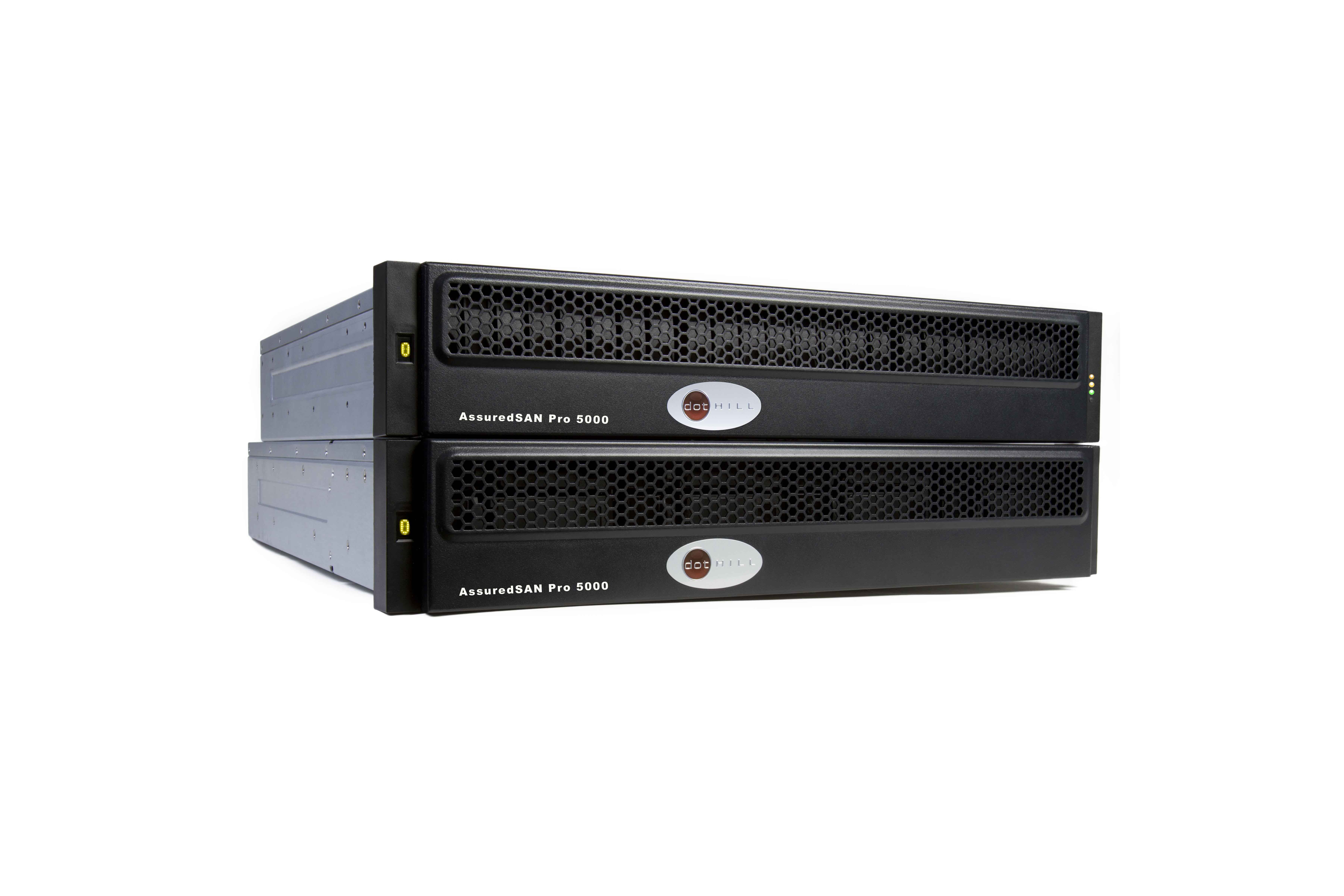

Dot Hill’s real time data tiering responds faster to changing access patterns than the competition and our tests show the AssuredSAN Pro 5000 delivers top FC performance. We found it straightforward to deploy and configure. Dot Hill can’t be beaten for value either.
-
+
Good value; Real-time migration of hot data to SSD; Simple configuration, Automatic tiering; Top FC performance
-
-
Web GUI has IE10 compatibility issues

Automated data tiering is an established technology but Dot Hill's AssuredSAN Pro 5000 takes it to the next level as it does it in real time. Other products use slow batch migration processes but Dot Hill's RealStor technology moves hot data to an SSD-based cache in seconds making it far more responsive to changes in access patterns.
In this exclusive review we put the Fibre Channel model on the lab bench. The system supplied comprised a 2U 24 SFF bay head unit with dual controllers and redundant PSUs plus a second 24 SFF bay disk shelf.
Each controller has four 8Gbits/sec FC ports and as they run in active/active mode, all eight ports are available. The controllers each have dual 6GB/sec SAS expansion ports and can handle up to eight additional expansion shelves for a total of ten.
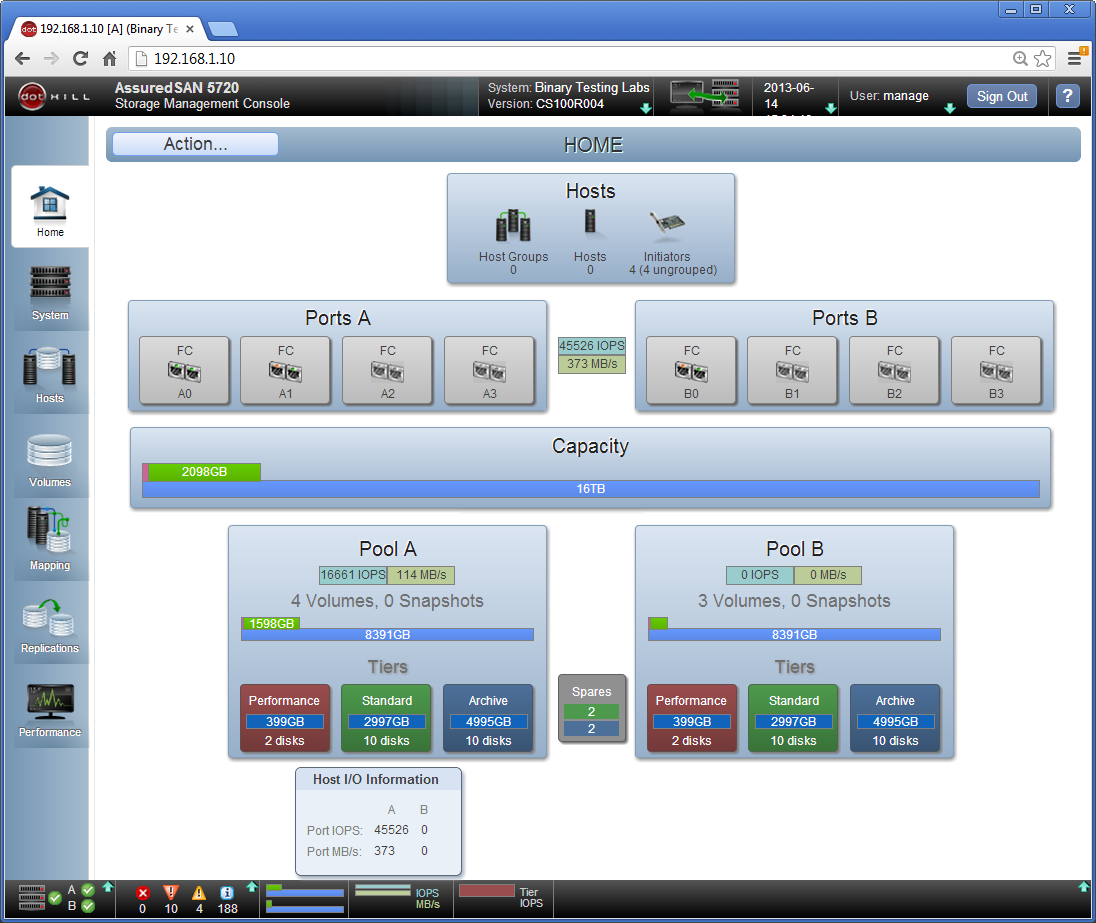
The intuitive web interface provides an overview of all drives, tiers, pools and ports plus wizards for every conceivable task
Dot Hill's RealTier
The Pro 5000 supports up to three storage tiers with the Performance tier comprising SSDs. The Standard tier uses 10K SAS drives whilst the Archive tier employs high capacity nearline SAS drives.
Dot Hill's RealTier handles data classification and migration. It breaks the data up into 4MB pages and monitors access patterns to determine what's hot and what's not.
Using a ranking score based on page access frequency, it determines what to move up and down the tiers. RealTier scans its page scores every five seconds and moves the data to the appropriate tier.
High scoring pages get shifted to SSD whereas low scoring pages are moved to the Standard or Archive tiers. Overheads are reduced as no more than 80MB of data is moved in each five second period.
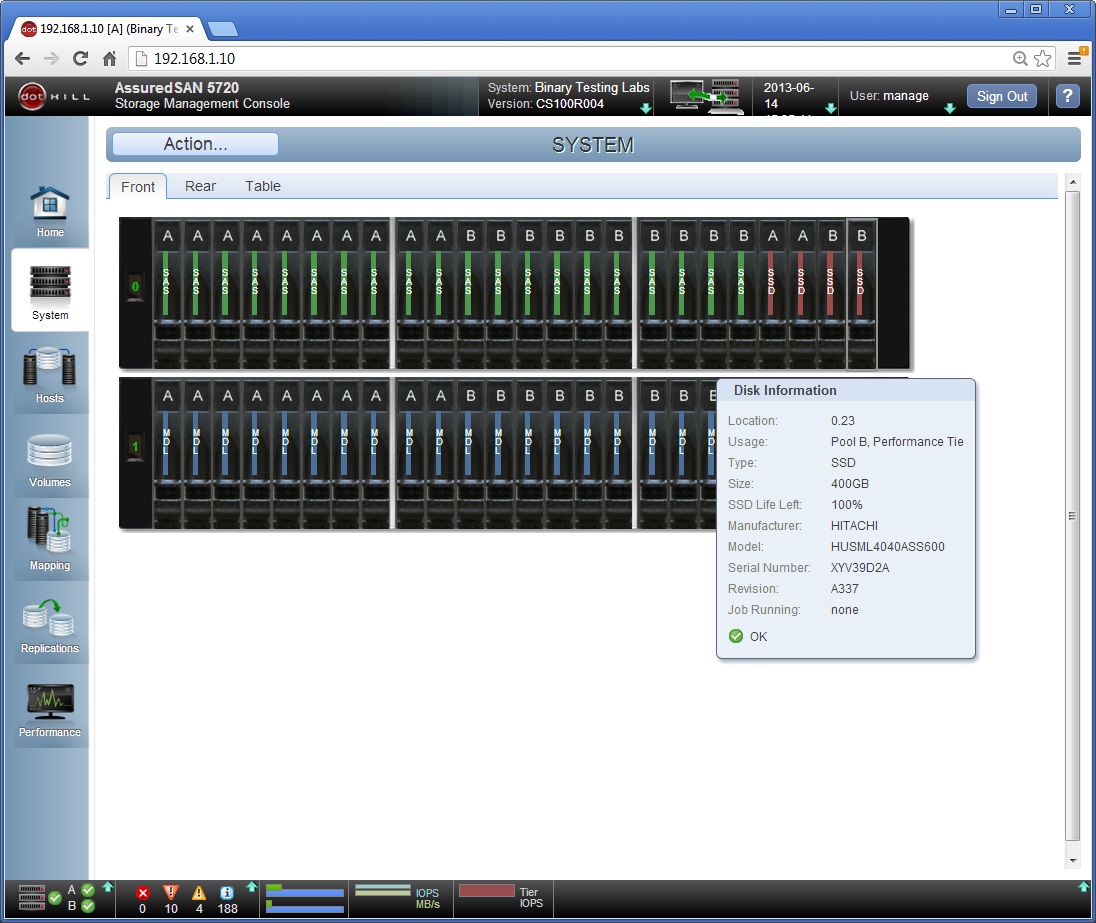
Our review system came with SSDs, 10K SAS and 7K NL SAS drives to provide three tiers for data migration
Deployment
Setup is very simple as all tier creation is fully automated. The web interface is intuitive although we had to use Google Chrome as it wouldn't display properly with IE10.
The Performance tier places the SSDs in a RAID-10 array whilst the Standard and Archive HDD tiers use RAID-6. Storage pools group the drives together and are assigned to either controller.
Our test system had four SSDs, twenty-two 10K SAS drives and twenty-two NL SAS drives. The wizard automatically created two pools each with two SSDs, ten 10K SAS plus ten NL SAS drives and kept two SAS and NL SAS drives back as global hot-spares.
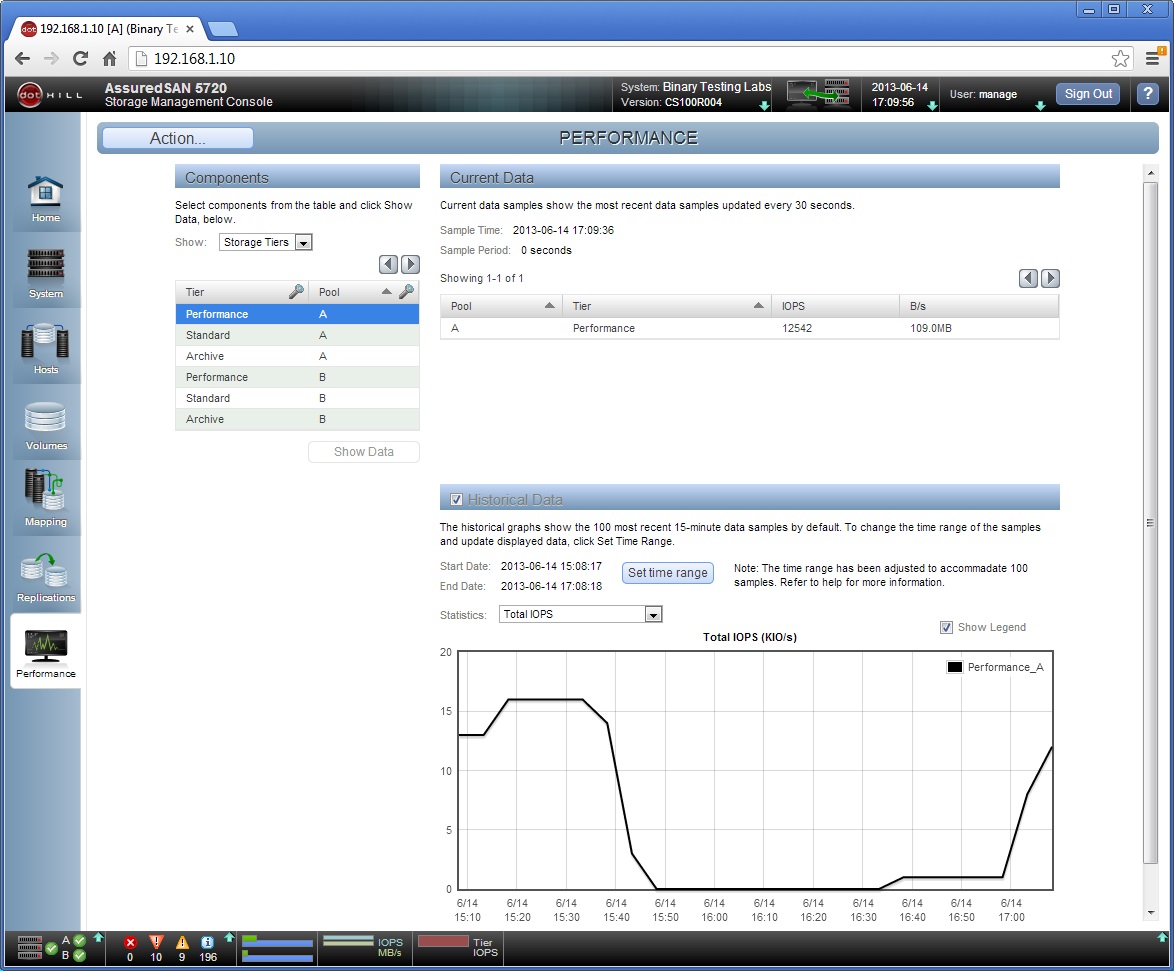
For performance, you can monitor IOPS throughput for pools, tiers, volumes and controllers
Volumes and thin provisioning
The wizard then moves on to volume creation. Using Dot Hill's RealThin, thin provisioning is applied automatically and the Pro 5000 supports LUNs up to 128TB in size.
Volume creation is a cinch as you choose a name, a size and the pool you want to use. Further control over migration is possible as you can assign a tier affinity to each volume.
If the volume is likely to be used for high access data you assign it an affinity with the Performance tier. Likewise, if it's going to be used for tasks like backup data, you can assign it an Archive tier affinity.
As thinly provisioned volumes get used, alerts keep you posted on the status of physical capacity. Before it gets critical you can deploy new shelves where their drives will be added to the correct tier automatically based on their type.
The optional Data Management software bundle costs 4,000 and includes snapshots which can be run on-demand or scheduled. To rollback a volume you select this option from the Actions button and pick a snapshot to go back to. Next is AssuredCopy which copies entire volumes locally whilst AssuredRemote replicates to a remote appliance for disaster recovery.
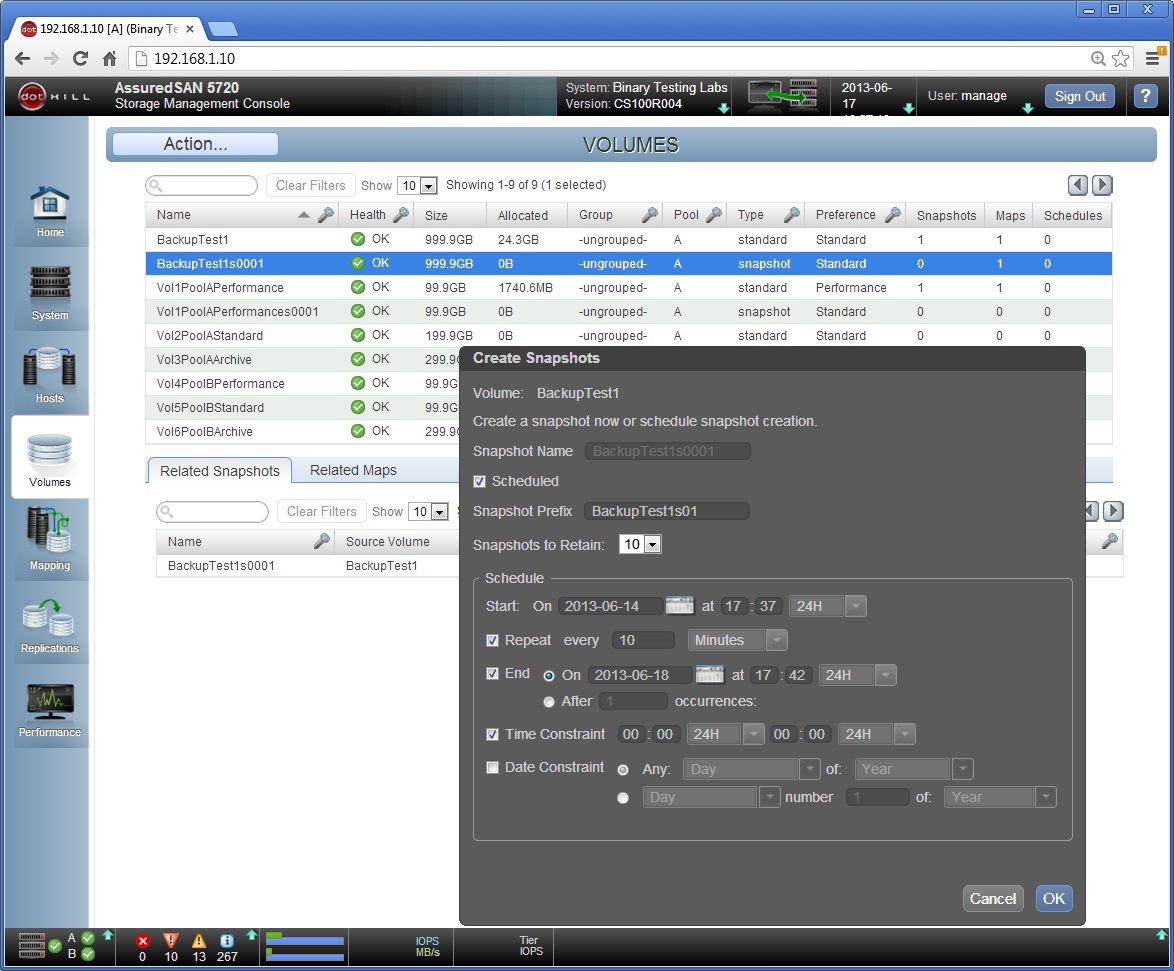
Volumes are simple to create and snapshots can be scheduled to run at regular intervals
Performance testing
To test the Pro 5000 we used a Dell PowerEdge R515 rack server running Windows Server 2012 and equipped with a QLogic dual-port 8Gbits/sec FC HBA. Using a point-to-point link, we found the mapping process swift as the web interface automatically discovered the host on connection allowing us to assign a volume to it.
As data is placed on the volume it goes first to the Standard tier and is then moved according to access patterns. When we fired up Iometer for 64KB sequential read and write requests, it initially showed a raw throughput of around 550MB/sec.
RealTier came into play and within a minute speed has increased to 750MB/sec which equates to nearly 6Gbits/sec. We could see in the web interface that all I/O activity has shifted from the Standard to the Performance tier.
We also tested IOPS using 8KB random read and writes. Our results were better than Dot Hill's as we recorded high rates of 46,000 IOPS and 15,000 IOPS respectively. Conclusion
With a base two tier system costing around 46K and the three tier system on review costing 48K, the AssuredSAN Pro 5000 beats the competition hands down for value. Deployment is simple as most functions are fully automated, FC performance is very good and it scores highly for its real time data migration.
Verdict
Dot Hill’s real time data tiering responds faster to changing access patterns than the competition and our tests show the AssuredSAN Pro 5000 delivers top FC performance. We found it straightforward to deploy and configure. Dot Hill can’t be beaten for value either.
Chassis: 2U rack
Controllers: Dual hot-plug
Memory: 4GB cache with capacitor backup
Storage: 4 x 400GB Hitachi SSDs; 22 x 600GB Hitachi 10K SAS, 22 x 1TB Seagate 7K NL SAS
Network: 4 x 8Gbits/sec FC ports per controller
Power: 2 x hot-plug 573W PSUs
Management: Web browser, CLI
Get the ITPro daily newsletter
Sign up today and you will receive a free copy of our Future Focus 2025 report - the leading guidance on AI, cybersecurity and other IT challenges as per 700+ senior executives
Dave is an IT consultant and freelance journalist specialising in hands-on reviews of computer networking products covering all market sectors from small businesses to enterprises. Founder of Binary Testing Ltd – the UK’s premier independent network testing laboratory - Dave has over 45 years of experience in the IT industry.
Dave has produced many thousands of in-depth business networking product reviews from his lab which have been reproduced globally. Writing for ITPro and its sister title, PC Pro, he covers all areas of business IT infrastructure, including servers, storage, network security, data protection, cloud, infrastructure and services.
-
 Nvidia braces for a $5.5 billion hit as tariffs reach the semiconductor industry
Nvidia braces for a $5.5 billion hit as tariffs reach the semiconductor industryNews The chipmaker says its H20 chips need a special license as its share price plummets
By Bobby Hellard Published
-
 Business leaders are having a crisis of confidence over data literacy
Business leaders are having a crisis of confidence over data literacyNews A Salesforce survey reveals business leaders don't trust their data, or their ability to make the most of it
By Emma Woollacott Published
-
 MITRE CVE program handed last minute reprieve amid funding lapse concerns
MITRE CVE program handed last minute reprieve amid funding lapse concernsNews The MITRE Corporation's Common Vulnerabilities and Exposures (CVEs) database has been handed a last minute reprieve amid concerns over funding.
By Rory Bathgate Last updated